examples of silk screen printing
If there is ever an arena where the printmaker is able to play and experiment it is for sure with the screen printing technique. Allowing a diverse range of surfaces for production, and with it breaking up the border between the consumerism arena and the bubble of fine art editions, screen prints, also known as silkscreens, since their big entrance to the world of art in 1960's are continuing to hold an important place within intaglio printmaking methods.
Differing greatly from traditional techniques, such as aquatint for example, major artists of the 20th-century embraced the fact that the method of screen printing production allowed for flat areas of vibrant hues to take a step forward, offering not just the experimentation with different hues, but the embrace of collage techniques and the various print combinations.
Their investigation into the screenprinting media and experimentation produced some of the most memorable print images and greatly influenced the silkscreen print production, graphic design, poster works, and garment printing of the present.
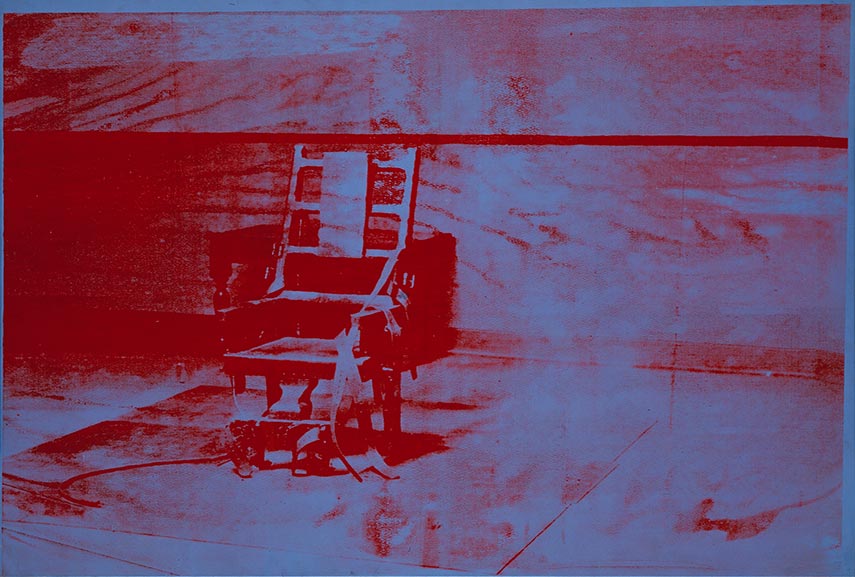
The History of Screen Printing
Understood to originate from the traditional stenciling technique, itself one of the earliest forms of duplication of images[1], what we know today as screen printing took centuries to develop. The earliest story of stencil production originates from the tale of Polynesia and its inhabitants, the cutting of the banana leaves and the pushing of the ink through it for the production of a specially printed cloth called tapa [2]. Yet, the style of screen printing as we come to know it today originates far back to the era of Song Dynasty Art in China, around 960 – 1279 CE. A truly remarkable level of expression and mastery was reached by the Chinese artists for the creation of special masks, also known as matrixes, what we today understand as a modern screen printing frame[2]. The making of such masks was an extremely complex process. The small pieces, which created the mask, were glued together with human hair allowing perfect ink passage. Adopted as such and re-defined in Japan, it arrived in Europe around 1907. It was due to the success of the Japanese textiles show at World Fairs that the craftsmen in England and France began to use screens made of silk with stencils from impregnated paper for printing on fabric. The move towards using silk in screen printing needed to be made due to the demand for elaborate pattern design and it was firstly patented and used by the Englishman Samuel Simon [3]. Simon's adaptation of the technique was put to use for the printing of high-quality custom wallpaper or to print on silk or linen material and a clientele of upper class followed closely by.
It was soon after, in 1910, that the screen printing technique underwent further changes and development. The experimentation with photo-reactive chemicals, in particular, the chromic acid salt sensitized emulsions by Roy Beck, Charles Peter, and Edward Owens produced photo-reactive stencils. This innovation proved to revolutionize the commercial screen printing industry.
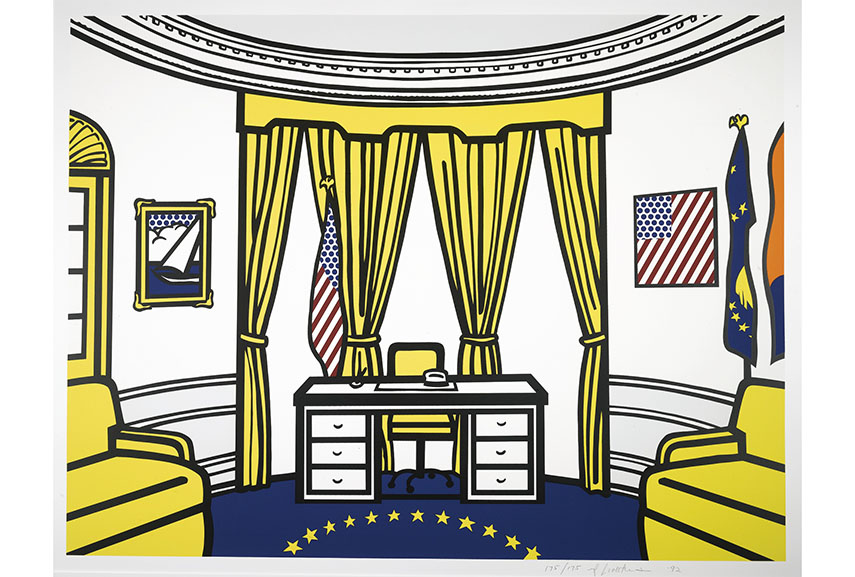
Pop Go the Silkscreen Images
For much of the 20th-century, this printing method was kept confidential and protected as a 'trade secret'. As an artistic form, it appeared for the first time in the USA, where since the 1930's screen printed images were shown at exhibitions and received much appreciation in the art market. It was during this time that the term serigraphy was coined to differentiate the artistic application of silkscreen printing from the industrial use[4]. The term is coined with the use of the Latin word sēricum" (silk) and Greek "graphein" (to write or draw). In Europe, the screen printing art was used after the Second World War[5] while some of the famous European artists, such as Henri Matisse relied on the stencil technique, known as pochoir for the creation of their printed editions.
Yet, it was with the emergence of Pop Art during the 1960's and its love for popular culture along with its iconic figures that the true face of screen printing was born. The traditional application of the technique for the production of printed images in service of decoration and advertisements received new vocabulary and produced a new idea of the aesthetic in the hands of Andy Warhol . Using the screen printing method to its fullest, playing along with the idea of appropriation and the isolation from the traditional hands-on approach by the artists, Warhol produced some of the most striking images. Realizing the full potential of the medium the artist used and re-used images, experimenting with repetition art and some of the most daring choices of color not to mention subject matter. Warhol's interest in the iconic film and music stars for some is considered to represent that superficiality and adoration of the glittering surface of the American popular culture of the day, but many considered his choice of subject matter to stand for deeper issues and anxieties surrounding death. The famous silkscreen print of Marylyn Monroe, one of the firsts for Warhol, was produced slightly after the actress's death.
Check out more works by Andy Warhol on our marketplace!
Alongside Warhol major artists such as Roy Lichtenstein , Robert Rauschenberg , Jim Dine , Richard Hamilton , and the famous sister Mary Corita Kent, produced striking images combining words, letters, images from the newspaper, photographs, using the dots and pixels that were until then, part of the newspaper and advertising world, as a fresh idea of the new artistic marks now possible due to the screen printing technique.

The Technique of the Screen Printing Method
The versatility of screen printing is one of the main reasons why many artists and designers turn towards this medium. Apart from existing as a 'traditional' form of printed art on paper, screen printing makes up a large percentage of printed garment works. From t-shirt designs, to elaborate patterns on a variety of textiles, to the printed images on wooden or metal surfaces, or as some of the most memorable graphic design pieces and poster art collectables, screen printing, allows for a great amount of diy and unlike some of the earlier printmaking techniques, printing can be done outside of an artist's studio. You can print even at home, on your kitchen table for example, and this one cannot imagine possible or easy if one thinks about the etching technique and the use of the acid. The water is your best friend once it comes to printing, and of course, the materials such as emulsion, inks, and metal or wooden frames, that are in a sense plates that hold the image desired for printing, need to be of good quality yet a certain level of experimentation is possible even here. Apart from the traditional screens, many turn to an embroidery hoop and stencils to produce their images.
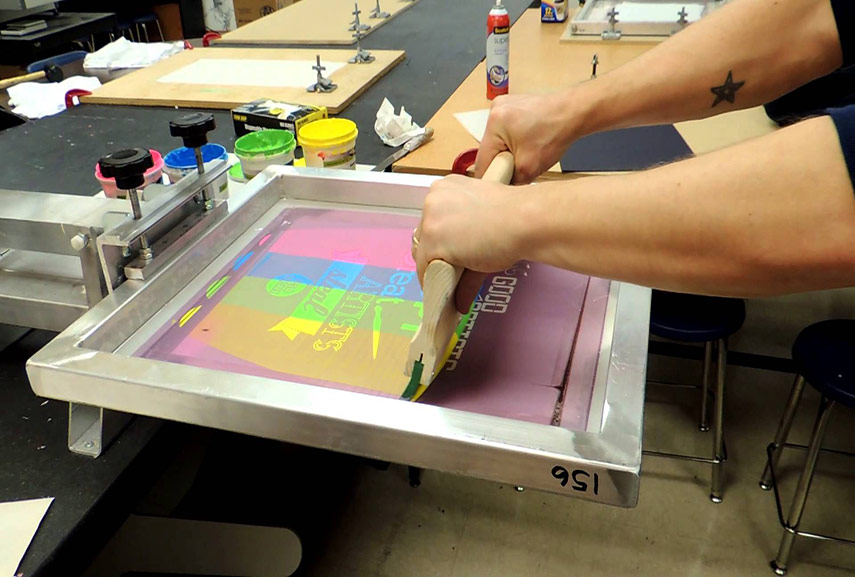
The Method of Printing
Today there are three major screen printing presses and they are the flat-bad, cylinder, and rotary machines. The first one is for sure the most popular one used. Unlike other print methods, screen printing allows for a greater thickness of the ink than in any other printmaking process and as mentioned above, the versatility of surfaces is high. Today different logos, banner, labels, signage, and electronic circuit boards are produced with it[6] >. Many still enjoy the hands-on approach and avoid using the printing machines. The mistakes and the marks of the hand printing are what add that magic to the printing
There are several important steps one needs to follow in order to create a perfect silkscreen print. The beginning, as it always is, is in the drawing or a sketch and one needs to bear in mind the size of the frame onto which the image will be transferred and the fact that your drawing or design is what your image will look like. Unlike with etching, linocut, or drypoint one doesn't need to draw in reverse ie. as a mirror reflection. There are two ways you can go about creating your image. The first one is that you can cut out your stencil , making sure that you keep the edges nice and that you don't cut or dig a hole anywhere where you don't want the ink to pass through. Once you have carefully cut out a stencil, you can use the above-mentioned embroidery frame, which you place above your stencil, which you have beforehand placed on your desired material. This best works for home craftsmanship and printing of your own t-shirts for example. Once you have placed the material or paper in place and aligned the stencil and the screen, with a small spoon or a knife you take the desired color out of its container and place it slightly above your image. Not on your image but above since with a special blade known as a squeegee in one stroke you will need to cover your frame with color. The frame for this first stroke needs to be lifted slightly off the surface you print on and once you see that the color has covered all the parts of the image or the stencil you repeat the stroke after you have lowered the screen on the surface. The empty areas on your stencil will allow for the ink to pass through while the material which you have used to create your stencil will block the ink passage.
What we first described to you is one way you can print but the fact is that to truly print silkscreen three major steps you need to conquer. This applies if you wish to print an image that you have prepared in a digital format or as a drawing on a see-through paper or foil. The first step for this is the pre-press process, and it is here that you cover the screen print frame, made of porous mesh stretched tightly over a frame, with a photosensitive emulsion. The next step is the exposure of the image, where the exposure unit burns away the unnecessary emulsion leaving behind a clean area in the mesh with the identical shape as the desired image. With low water pressure, the excess amount of the emulsion is washed off. The step for printing takes the same format as what we described above with the stencil. Do allow yourself time to align everything in place. This is really important, especially if you desire to print with more than one color. For every new color, you will need to use another screen and it is like a collage or different layers in computer programs that you will build your image. With great care after every color is printed lift the screen and gently remove the paper of it. Sometimes your screen will get blocked and the passing of the ink may become difficult. With a cloth gently wipe out the excess amount of color and continue printing. After you are finished with a greater force of water you will clean your screen and leave it until you get a desire to create more.
Screen Printing Materials
As we could see, screen printing is a fairly easy technique to learn and do on your own. However, in order to get creative, one must get their hands dirty, and here we are talking about supplies and equipment of many, many kinds[7]. As a result of the evolution and progress of print making, we now have several categories of ink, screens, frames, mesh, chemicals, heat transfers and even software, as well as printers, dryers, presses, plotters and platens in the equipment department. Of course, the choice depends on the desired imagery and availability of materials, so it is good to learn which material will get you to your goal.
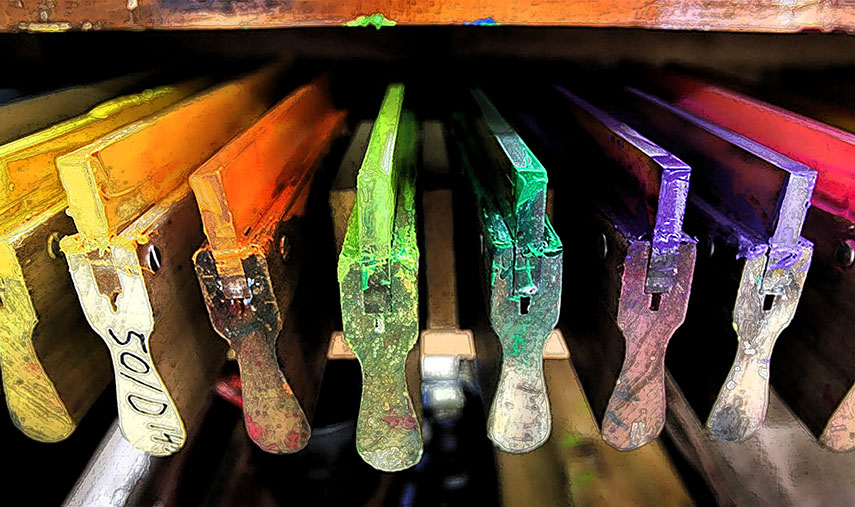
Screen Printing Supplies
Essentially, the first thing that comes to mind is the ink. There are two main categories: Plastisol and Water-based inks. Plastisol is the most common ink, used in commercial garment decoration. Because they are plastic-based, they require heat cure for 45 seconds at 320 degrees Fahrenheit (160 degrees Celsius). They are good for foil applications and stretch products, for example, and they also provide 3D or glow-in-the-dark effects, which could be made softer with special additives or heavier by adding extra layers of ink. The subcategories of Plastisols are many. For instance, the Athletic and polyester inks solve the issues with printing on cotton/polyester. Apart from the black, white, color and special effect inks, the ones to pay attention to most when using a four color printing process, or CMYK process, are the IC MP and Pro-Bright Process Inks. These are meant to be mixed together and should not be printed separately. They are transparent in nature, so it is recommended to keep a curable ink reducer close during the printing, in case one of the colors requires light adjustment.
As part of Water-based, we have Discharge inks used to print lighter colors onto dark background fabrics. By removing the dye of the garment, you obtain a much softer, less graphic texture with little control over the exact color. Water-based inks are generally more popular, because of vintage feel they give to the images.
There are many ink additives which work for both Water-based and Plastisols - here we have cracking ink, which imitates intentional cracked surface after drying; or flocking, consisting of a glue printed onto the fabric after which flock material is applied for a velvet touch, similar to foil, which has a reflective/mirror look to it. Nylobond is a special additive for printing onto technical or waterproof fabrics, while Suede offers a more puff-u look and is added to Plastisol. Another relatively new breed of ink is the PVC and Phthalate Free, which is like Plastisol but without the two main toxic components. Like Plastisol, it provides a soft texture.
Passing onto screens and frames, there are mainly those made of aluminum and wood, varying in size. These are accompanied by emulsion scoop coaters, for proper application, and squeegees, which include blades of different durometers glued into the base for printing and cleaning. From the mesh section, there are films and output inks, such as Laser and Inkjet Waterproof films. In chemicals, you can find everything from aerosols to cleaning chemicals like dehazers, degreasers, screen washers and ink and emulsion removers. Among the heat transfer materials, choose between transfer paper, adhesion powder, foil and actual press, depending on the type of base and ink.

Screen Printing Equipment
Let's assume you've decided to go big on the whole screen printing business, and this means creating a proper dark room. Like the aforementioned press, there are other machines that can help you accelerate the process, such as the conveyor dryer, or the flash dryer which are smaller, lighter and easier to store. The dark room, which should be completely sealed-off from light coming from outside of the room, dry, and kept at an optimal 65 to 75 degrees Fahrenheit (18 to 23 degrees Celsius), will also require additional equipment such as dip tanks, light safe bulbs, emulsion exposure calculator, the washout booth, screen rack, vinyl plotters and cutters…
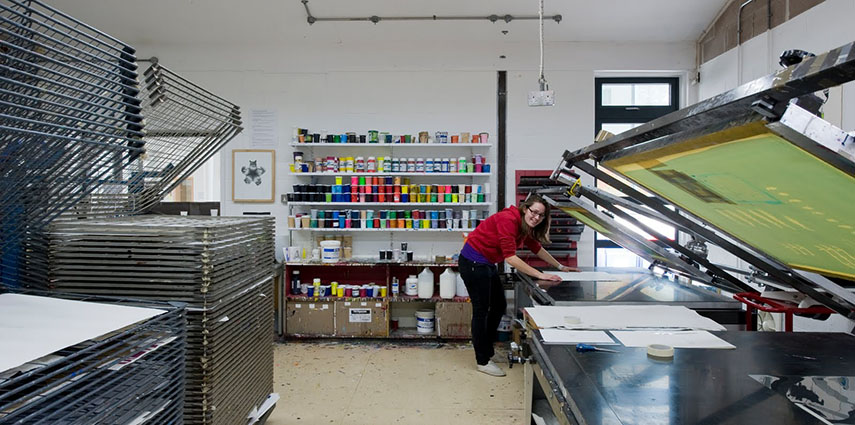
Famous Silkscreens
Printmaking surely is one of the most popular techniques among contemporary artists. From silkscreens and etchings to lithographs and woodcuts, many experimented with it and contributed to its evolution. For some, like Andy Warhol, it paid off big - his 1963 silkscreen Eight Elvises was sold for the spectacular $100 million to a private buyer back in 2008. Of course, the American artist produced some of the most memorable artworks in the field, which is why there are three of those featured on our list; but he wasn't the first and he certainly isn't the last to define the history of printmaking with some extraordinary visual artworks.
Andy Warhol Screenprinting
Ben Shahn - Pleiades, 1960
In the last stage of his life, a Lithuanian-born American artist Ben Shahn dedicated his graphic production to the exploration of alphabets and Hebrew was the one that got most of his attention. He even put them all together in a book of illustrations. Pleiades from 1960 is a screenprint in colors with gold leaf and hand-coloring on Japan paper, featuring the famous constellation and a text in Hebrew below, which shows his understanding and mastering of letterforms, in many languages. His are blocky, wonderful shapes with differing stroke lengths, still quite relevant in typography and graphic design.
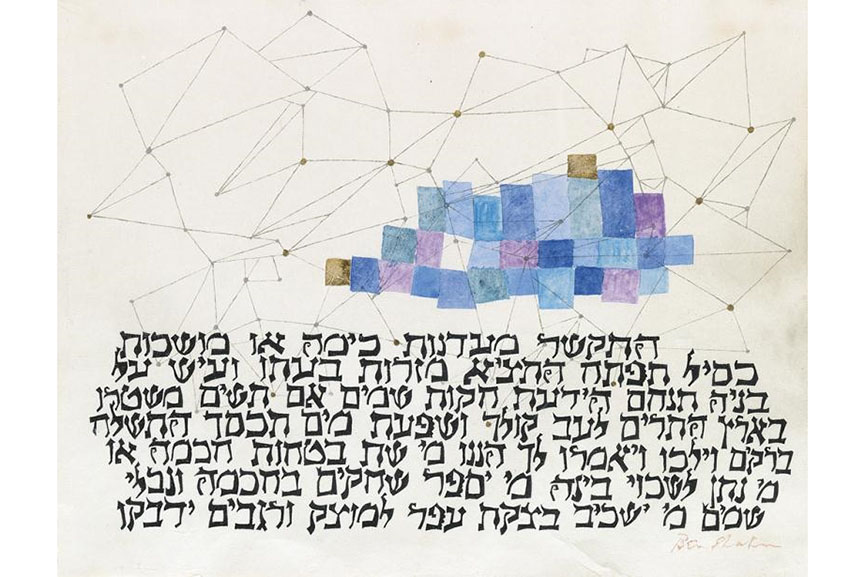
Robert Rauschenberg - Retroactive I, 1964
Robert Rauschenberg was always very interested in the iconography of American popular culture. A great example of this is the 1964 Retroactive I, the oil and silkscreen on canvas that belongs to the series of silkscreen paintings that Rauschenberg made between 1962 and 1964 and uses images of current events gathered from magazines and newspapers to form a collage. We see a large photograph of John F. Kennedy speaking at a televised conference, joined by another photo of an astronaut with a parachute and seemingly random color splashes. In all, it is a proper, Pop-artsy visual commentary on a media-saturated culture accepting the era of television.
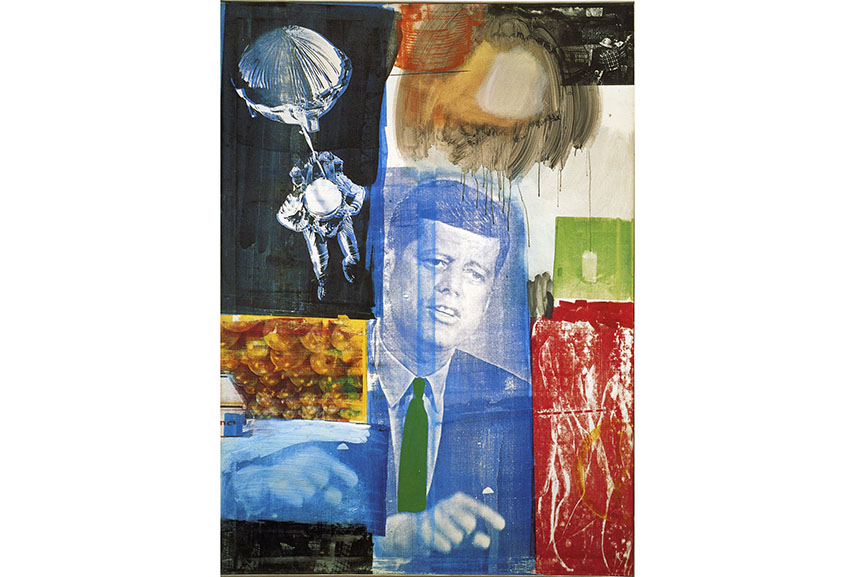
Roy Lichtenstein - Brushstroke, 1965
In 1965 and 1966, Roy Lichtenstein made a series of paintings that depicted large brushstrokes, commenting on the work of Abstract Expressionists, which Pop artists strongly rebelled against. The motif was then screen printed onto paper in a manner usually associated with advertising or publishing, in order to make it seem everyday and banal - depersonalized, mocked and, in a way - devalued. Lichtenstein was a prolific printmaker and he created several versions of brushstrokes, saying that "the real brushstrokes are just as pre-determined as the cartoon brushstrokes."
See more works by Roy Lichtenstein here!
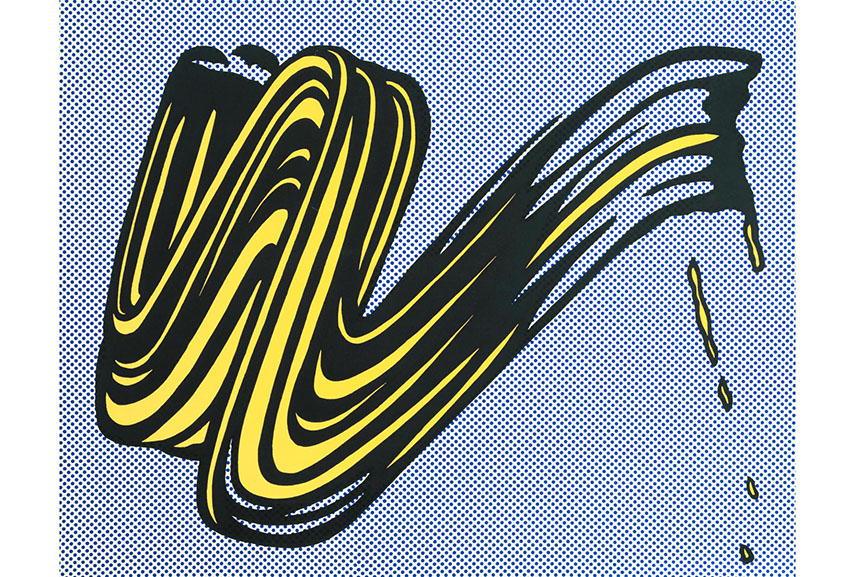
Andy Warhol - Campbell's Soup Can on Shopping Bag, 1966
If we can talk about the combination of fine art and commerce that Andy Warhol endorsed so much through his practice, the first topic would be his Campbell's Soup Cans printed on shopping bags. The image became synonymous with the Pop artist, and in 1966, these bags were printed exclusively for the exhibition of his works at the Institute of Contemporary Art in Boston, MA. These followed the creation of neon-colored paintings of the soup cans in 1965, when Warhol hit upon the symbol of the contemporary American consumerist society of the decade, perhaps with that image more than with any other in his production.
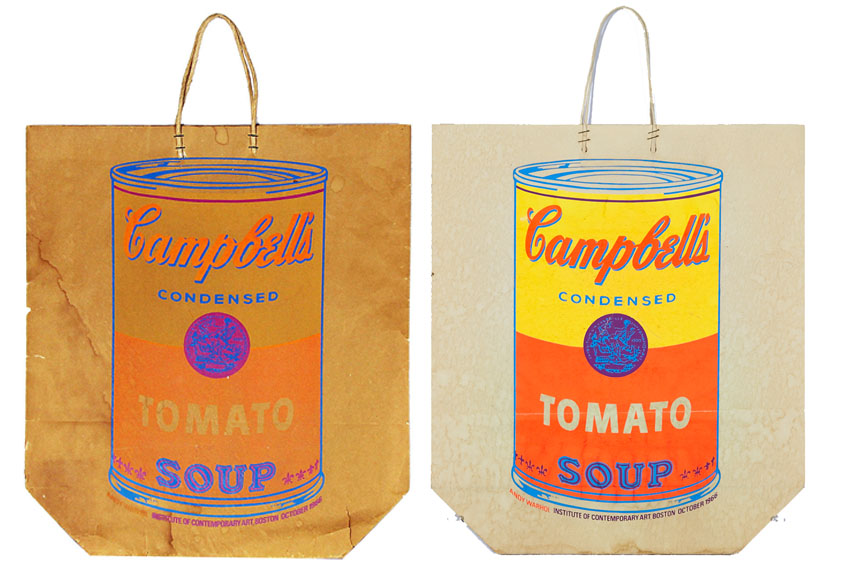
Andy Warhol - Marilyn Monroe, 1967
After he established a print-publishing business in 1967, called Factory Additions, Warhol created a series of screenprint portfolios on some of his favorite subjects, and Marilyn Monroe was the first one. The image we see below is one of ten screenprints, each of which featured the artist's signature motif and a distinctive palette of bright yellow, acid green and hot pink, often printed off-register to increase the impression of artificiality and industrial production. Each image was printed from five screens: one that carried the photographic image and four for different areas of color, and was rather small in size: six by six inches. When one thinks Pop art, they probably think of this image first, still as iconic as the day it was made.
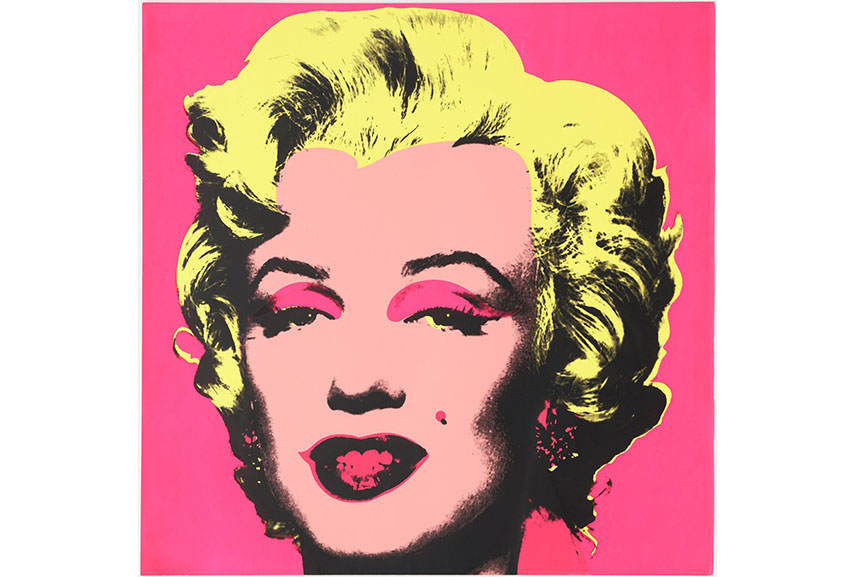
Andy Warhol - The Velvet Underground & Nico, 1967
It is a picture of a bright banana that ended up on the cover of The Velvet Underground & Nico's debut album which changed the way we perceive the yellow fruit. The original cover allowed fans to peel back the banana skin like a sticker, showing the nude-colored banana underneath in the manner of a sexually-charged effect and giving the manufacturers a lot to work on to make it perfect. The image became a commercial success (surprise, surprise) and it even led to a lawsuit between the Velvet Underground business partnership and The Andy Warhol Foundation of the Visual Arts, Inc., over who's got the right to call the image their own and earn money through it.
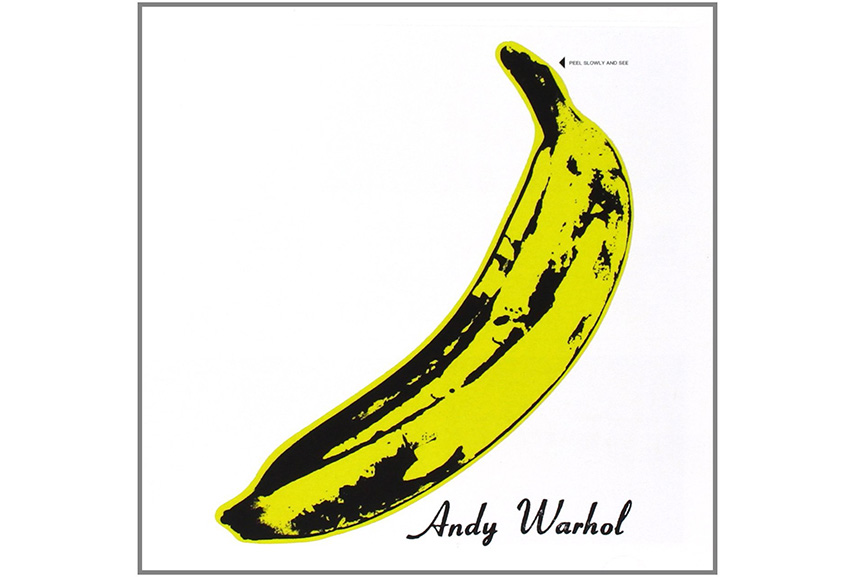
David Hockney - Lithograph of Water Made of Thick and Thin Lines and a Light Blue Wash and a Dark Blue Wash, 1980
Between 1978 and 1980, David Hockney created a collection of 23 lithographs, collaborating with printers like Kenneth Tyler, Roger Campbell, Lee Funderburg, Kim Halliday and Rodney Konopaki, on a special handmade papers. Preceded by several other similarly-looking images, the one below depicts a pool as one of the recognizable symbols of the easy-going lifestyle of Southern California and Los Angeles in particular, where the artist lived a while. He was fascinated with the texture and shades of water and used several techniques to depict it, including lithography, where he used simple colors and drawings that almost looked like doodles.
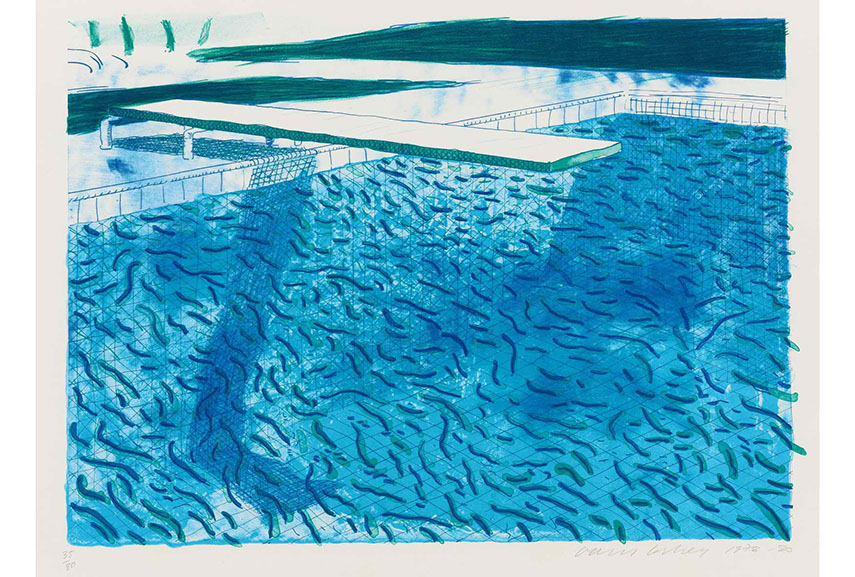
Erró (Guðmundur Guðmundsson) - L'ultima visita di Mao a Venezia, 2002
Icelandic artist Erró , born Guðmundur Guðmundsson, works in a variety of media, including painting, drawing, collage, printmaking, sculpture and film. His complex aesthetics are inspired by many art movements, styles and famous artworks, from Pop Art to Surrealism and Comics. Mao's last visit to Venice is one of his most recognized lithographs and graphic works in general, described as a Pop art persiflage of Socialist Realism, something Erró was quite interested in over the course of his entire career. With a deep blue background and a bright row of girls in the audience create a stunning visual juxtaposition and shows the artist's remarkable artistry.

Peter Blake - Love Me Do, 2004
Part of the Government Art Collection of the United Kingdom, Peter Blake 's Love Me Do screen print depicts the country's greatest band - The Beatles. A prominent figure in British Pop art, Blake derived it from the sleeve of the Sgt. Pepper's Lonely Hearts Club Band album he created for the band back in 1967, and made only 75 images within the edition in 2004, making it a rare collector's item. Reminiscing of Warhol's iconic four Marilyns, it shows the four members each in different uniform color. The print is covered with diamond dust, giving the boys a glittery feel in the spirit of a true post-Pop screen print.
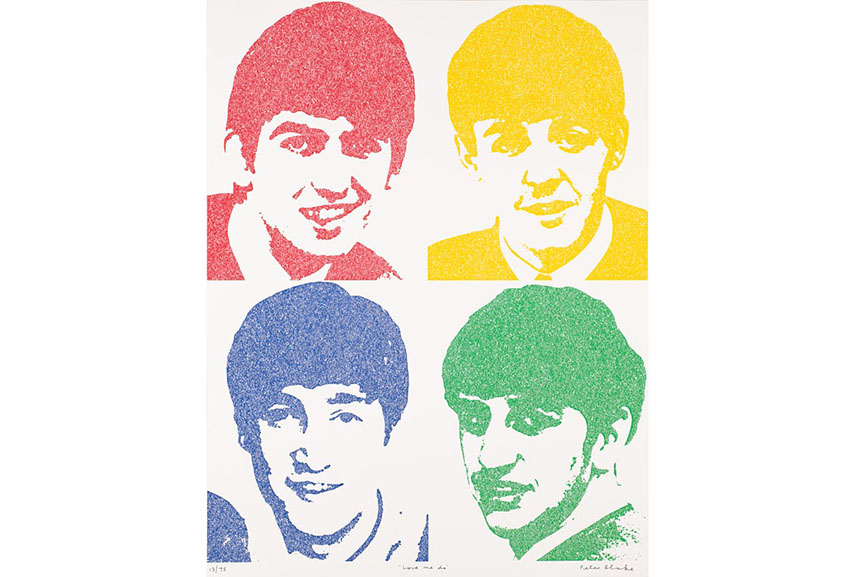
Shepard Fairey - Hope, 2008
Shepard Fairey 's HOPE poster was not the official image of Barack Obama's presidential campaign in 2008, but it surely was the symbol of it. The stylized portrait of the President in solid red, beige and (light and dark) blue, with the word "progress", "hope" or "change" below was initially conceived as a poster, but it quickly evolved into a stencil, which was even acquired by the Smithsonian Institution's National Portrait Gallery. After Obama won the election, Shepard Fairey stopped producing the print. The Guardian's Laura Barton even proclaimed that the image "acquired the kind of instant recognition of Jim Fitzpatrick's Che Guevara poster".
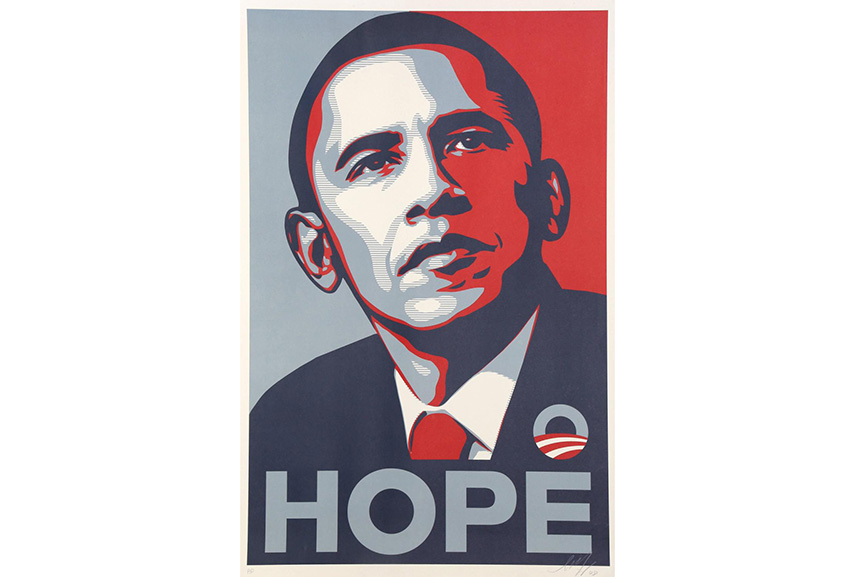
Contemporary Artists Who Screen Print
For any medium, it is crucial that the current times continue evolving it in new directions and consequently stop the genre from stagnating. Just like the case is with many contemporary movements still active today, 21st century's take on screen printing offers a lot of variations to the genre, continuing its natural development. Numerous practitioners took the screen printing technique down new roads, adjusting it to modern requirements and tastes, eventually proving the mediums adaptivity. Although many of these artists are not exclusively dedicating themselves to screen printing and are instead working in various methods, printing is nevertheless considered to be one of the more popular creative techniques to date. What follows is a list of the most prominent screen printers that are shaping the scene as we speak.
Blexbolex

Bernard Granger, better known by his pseudonym of Blexbolex, is a French illustrator who studied screen printing at the School of Fine Arts (L'école européenne supérieure de l'image) in Angoulême. This multi-award winning graphic artist is based in Berlin and has been working in the printing genre for over three decades. For the majority of his career, Blexbolex has been experimenting with the boundaries of his chosen medium, incorporating it with the different concepts of book production. Amongst other aspects of his work, Granger is praised for his fantastic ability to blend characteristic hand-drawn illustration with commercial printing techniques. His visual storytelling is also unmatched by any contemporary colleague.
Dan Mather
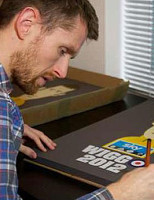
Dan Mather is a London-based screen printer and graphic designer, an independent artist who has collaborated with many United Kingdom's creative vanguards, such as Mash Creative and Glory Glory. Through his artistic output, Mather aims at erasing the barriers finding themselves between computer graphic design and hand-made screen printing, giving the genre a genuine 21st-century character. Dan works hard to constantly produce top-quality work, tirelessly creating or being involved with various projects. Mather is highly skilled, as evidenced by his exquisite screen printed images which have an amazing attention to details second to none - these details are the true focal points of Dan's art.
Faile
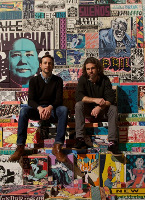
Faile is a Brooklyn-based collaboration between two artists, Patrick McNeil and Patrick Miller. This artistic duo was established during the year of 1999 and was a large part of the emerging street art culture, as well as DIY. It was through urban art that Faile learned and eventually mastered their practice on painting and printmaking that served them well in later stages of their career. They were also quite skilled with wheat pasting, stenciling and collage, making them the most versatile artists duo of the streets. Faile made a smooth transition from street activity to gallery pieces when they began exhibiting in the early 2000s. McNeil and Miller continue to work in numerous genres and styles, but their screen designs really manage to stand out due to imagery associated with popular culture.
DogBoy
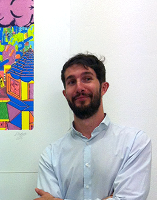
Dogboy, also known as Philip Huntington, is a London-based illustrator whose silkscreens explore alternate realities. This graduate of the Camberwell College of Arts often combines different digital methods in order to create his pieces. DogBoy is famous for his detailed and imaginative illustrations which can be interpreted as an intimate observation of fantastic anthropomorphic worlds. Huntington's screen print based pieces are often described as truly mind-blowing - which comes as no surprise when you consider his inspiration are found in Sci-Fi, psychedelia, Brutalism, the occult and mythology. Philip Huntington is currently a part of Dark Matter Collective where he produces silkscreens and drawings.
Jim O'Raw

Famous for his often use of fluorescent colors, Jim O'Raw is a screen print artist based in the Eastern part of London. He works between the UK's capital and Birmingham where he is a valuable member of the Birmingham Printmakers Studio. O'Raw specializes in CMYK process of printing which relies on fluorescent inks and glow in the darker pigments - Jim's print editions are some of the most characteristic ones the medium has ever seen. Looking at this artist's work provides the feeling of looking at faded film-developed photos - this distinct style helped Jim establish himself and set a promising platform for years to come. It should also be noted that O'Raw is the co-founder of Bridge Unltd - a t-shirt printing company with the focus on eco-friendly discharge inks.
Seripop
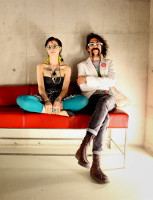
The second duo on our list, Seripop is a collaborative practice formed by a two Canadian artists, Yannick Desranleau and Chloe Lum. This Montreal-based duo has been active since the year of 2000 and goes by a famous motto: We are interested in all types of failure. Seripop loves experimenting with various fields of visual arts, making interesting works that incorporate elements of music and graphic design with the concept of screen printing. Their designs are used by numerous album covers and books but have also been exhibited in many reputed galleries and museums across Europe and America, with the definite highlight being their inclusion within a Victoria and Albert Museum show in London. Seripop won the 2007 Juno Award for CD/DVD Artwork Design of the Year for designing the cover of The Looks album by MSTRKRFT.
Mr.Bingo

Mr.Bingo is a celebrated illustrator, animator, graphic designer and screen printer who lives and works out of his studio in Shoreditch, London. He has been active on the scene since the year of 2001 and has been working for a large number of commercial clients in the last fifteen years. Most of Mr. Bingo's print works are limited editions represented by the Nelly Duff Gallery in London. His most famous project was the Hair Portrait series in which he depicted characters from Star Wars and The Mighty Boosh by drawing only their hair. Mr. Bingo collaborated with giant companies such as BBC Three, Oxfam, Orange and Microsoft, whilst his print works were featured in highly popular magazines like the New Yorker, TIME, Bearded, Dazed and Confused, WIRED, Esquire and GQ.
David Welker
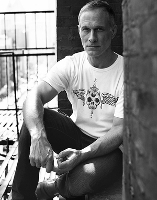
With his jaw-dropping work ranging from fantasy landscapes to urban realism, it comes as no surprise that David Welker is considered by many to be one of the most influential NYC-based contemporary artists working in screen printing. Welker is known for his complex and intricate rock posters, murals and paintings, while his images are widely accepted as some of the most detailed pieces of the medium's modern history. They are magical, mesmerizing, frightening and instantly recognizable. By his own acclaim, David's style is based on a blend of depression-era surrealism and contemporary underground comix. Welker is also rather skilled when it comes to typography as he relies heavily on lettering to enhance his art and the meaning behind it.
Screen Printing Today
One of the reasons why screen printing is so dispersed and why its popularity is constantly on the rise is the fact that almost every flat surface can be screenprinted on, no matter how new or old - think textile, ceramics, wood, paper, glass, metal, plastic… As such, the technique provides its practitioners with endless possibilities and materials, as we could have seen earlier, which means it is used in many fields inside and outside artistic circles[8]. For instance, the textile industry probably makes the largest use of this method, printing on fabrics ranging from cotton and organza to silk and polyester. These fabrics are then made into finished products like t-shirts, dresses, skirts, children's clothing, but also upholstery, curtains and drapes, cushion covers, bed sheets and covers; in fact, many designers set up their own design and screen print it in limited quantities.
Another industry that extensively uses the method is marketing and advertising, as flyers, posters, handouts, advertisements, even balloons and other graphic products all heavily rely on screen print. The reason behind the wide use is because it is easy to make limited edition prints, which are required by the market, as well as because the costs of creating are fairly small. Something similar can be said for the sports souvenirs and collectable items, such as t-shirts, jerseys, caps, sweatshirts, as well as mousepads, keychains, baseball bats, skateboards, snowboards and many others. The truth is that examples can be spotted anywhere if you're curious, on medical devices, printed electronics, pinball machines, accessories, product labels…
It goes to say that, with the development of technologies, digital printing became an important part of the field, growing strongly at the expense of screenprinted output[9]. In fact, the latter might soon become a marginal technology, with the only role of doing jobs that the digital cannot perform (yet). Digital printing is a much newer process that involves an artwork being processed by a computer and then ink-printed directly onto the surface of the product, without the heat transfer or appliqués. It is perfect for items that require high amounts of detail, which subsequently allows for photographic prints, although it can't be used for larger quantities. However, screen-based methods are still the more versatile ones, and because they are done by hand, the printer can manually handle curved or uneven surfaces as well and create unique products like water bottles, doozies and mugs. This only proves that no matter how digital the age we live in gets, screenprinting will aim to survive it thanks to its originality and accessibility which, like any other craft, cannot be replaced by a machine.
Written by Silka P , Angie Kordic and Andrey V. .

Editors' Tip: The Complete Book of Silk Screen Printing Production
This book covers the best of the two worlds, the practical and hands on information that covers a range of silk screen printing, and the story of the technique's beginning and development. As one of the most versatile printing methods, silkscreen images surround us all, from the art edition prints, T-shirt designs, stencil images, poster designs, and book illustrations. The author, himself an expert in the field with over 25 years of experience, explains the basic tools and equipment necessary, different approach to printing depending on the printed surfaces and desired effects. For anyone that has ever wondered how their favorite silk screen image was produced this book will provide all the answers.
References:
- Anonymous, Silkscreen Printing , Encyclopedia of Printmaking Art [August 27, 2016]
- Carnevale, M., History of Screen Printing , Mismatic Screen Printing Machines and Equipment [August 27, 2016]
- Pete (July 18, 2016), A Brief History od Screen Printing , Executive Date Control [August 27, 2016]
- Anonymous, Screen Printing , Wikipedia [August 27, 2016]
- Zegrer, M. (October, 2004), Silkscreen Printing , Artelino - Japanese Prints [August 27, 2016]
- Anonymous, Print Process Descriptions Printing Industry Overview: Screen Printing, Printers' National Environmental Assistance Center [August 29, 2016]
- Anonymous, Applications of Screen Printing , What Is Screen Printing [September 1, 2016]
- Anonymous, Briefing: Screen Printing to Survive in Niche Applications , Smithers Group [September 1, 2016]
All images used for illustrative purposes only. Featured image in slider: Richard Hamilton – Adonis In Y Fronts, detail. Image via img.nowness.com; Andy Warhol – The Skull, detail. Image via altertuemliches.at; Jim Dine - Drag. Image via saatchigallery.com; Richard Hamilton – Stage Proof-1. Image via tate.org.uk.
examples of silk screen printing
Source: https://www.widewalls.ch/magazine/screen-printing-silksreen-prints
Posted by: silvasessood.blogspot.com



0 Response to "examples of silk screen printing"
Post a Comment